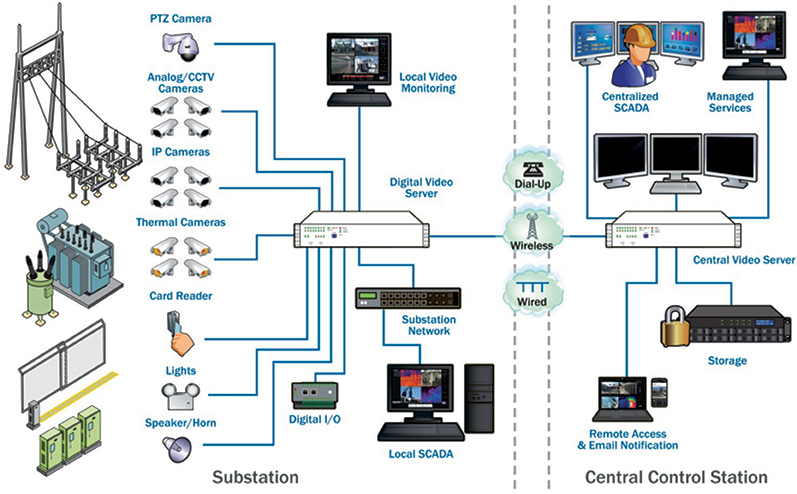Twenty-first century electric power utilities are faced with complex operational issues and challenges with respect to physical security of critical assets, particularly substations. These can include security threats to infrastructure and remote facilities, aging equipment and support structures, safety of personnel and the public, and overall rising costs due to unplanned maintenance, brownouts and even blackouts.
Video monitoring solutions are playing an increasing role in addressing these issues and, although typically used for security, they have the versatility to be used for a wide range of applications including equipment monitoring, asset management, and substation automation. In each case improved operations through automatic detection of events and other valuable information, can be obtained by automatically analyzing the content of the captured video through analytic software algorithms.
Challenges for Electric Utilities
Electric utilities provide a mission critical function and as such must ensure a reliable and stable flow of power at all times. Security threats, unplanned maintenance, malicious damage, and theft of materials are all increasing the operational costs for the utility in addition to increasing risks of brownouts and blackouts. These issues are further exacerbated by limited available personnel and unmanned facilities.
Energy providers are looking to technology more and more to help deal with these as there is currently a lack of automation systems that actually monitor the condition of critical equipment at substations and elsewhere on the grid. The industry has its own set of unique challenges, however, when deploying technology-based solutions. These include: finding solutions that are highly reliable and can withstand harsh substation environments; the high cost of equipment serviceability; implementing adequate connectivity solutions; interoperability with existing systems; and complying with evolving regulatory requirements such as NERC critical infrastructure protection (CIP).
The harsh substation environment is particularly problematic and requires specialized solutions. High levels of electromagnetic interference (EMI); wide temperature ranges; vibration and shock; and the presence of destructive pollutants all have the potential to interrupt or degrade performance of electronic equipment. As a result, design requirements must be more rigorous than those used for commercial grade installations. Although ‘lesser’ technologies used in such substations will work initially the inherent stresses will eventually surface and cause equipment failure.
Video Monitoring Applications
Two categories define applications:
- Security
Video monitoring is a key tool used to prevent and investigate theft, unauthorized access, vandalism, sabotage, terrorism or other uncontrolled damage to critical infrastructure. In recent years, high value metals found in electrical components are favorite targets and unmanned remote sites offer little obstruction to thieves. Apart from the theft, physical damage and destruction is often caused during the commission of the crime. Unplanned repair and replacement costs notwithstanding, brownouts and even blackouts can occur as the grid feed is ‘taken.’
A vital part of the intelligent video monitoring system is the capability to proactively alert personnel of an intrusion allowing security personnel to be quickly dispatched and any crime thwarted. Incidents are also recorded to provide investigators an opportunity to determine who perpetrated the crime after the fact.
Complying with regulatory requirements, such as the NERC physical security standard aimed at controls to physically protect critical assets, is another area where video monitoring plays a vital role. Integrating video with access control provides the backbone of a physical security strategy that satisfies both NERC and general utility requirements.
- Asset Monitoring and Substation Automation
Without adding personnel, improved efficiency and reliability of utility operations can be ensured by continuous and automatic remote monitoring of critical substation components. Early warning of impending equipment failures helps increase reliability without adding personnel. The chance of failures and downtime are reduced and asset lifecycles can be extended through preventive maintenance. The cost of protecting the utility’s assets is negligible compared to the unit cost of the asset.
Intelligent video monitoring systems that utilize thermal cameras enables automatic detection of temperature increases in substation equipment. Through sophisticated video analytics algorithms for smart detection of anomalies, thermal signatures are analyzed and used as precursors to actual failures. ‘Thermal rules’ can be implemented to trigger automated alarm and email notification of possible issues. With the cost of thermal cameras coming down in recent years, automated thermal analysis has become a more cost effective tool in substation automation.
Integrating video into SCADA systems that are used to monitor and control an electric utility’s operation is the next logical step. It provides enhanced understanding above and beyond that which can be obtained from graphical representations and numerical readouts. Visual confirmation of events or issues is particularly useful when personal safety is involved, such as verifying whether or not a breaker is open or closed before an operator enters an area.
Video Monitoring Solutions
A typical video monitoring solution utilizes components such as cameras, video recorders, servers, networking equipment, storage devices, and auxiliary equipment. Figure 1 illustrates a typical architecture for electric utilities and highlights the distributed nature of the utility infrastructure. This dispersed infrastructure raises a problem for video streaming as many substations are located in remote areas with no personnel on site and many times with only a low bandwidth channel for communications.

Figure 1: Video Monitoring Architecture for Electric Utilities
(click to enlarge)
Digital Video Server. A digital video recorder (DVR) records video in a digital format to a disk drive or other medium. DVRs are typically located in close proximity to the camera(s) as they are generally directly connected to each other. With the proliferation of Internet protocol (IP) cameras, however, a direct connection is no longer required as video can be transferred over an IP network through switches and routers. These DVRs are referred to as network video recorders (NVRs).
The digital video server (DVS) is a new class of recorder that has all of the capabilities of the DVR and NVR, but makes it possible to integrate IP and analog cameras. Added functionality, such as digital I/O and SCADA can be incorporated into the DVS.
Cameras. Camera types fall into one of two categories – analog and IP, with analog currently being more widely used. Although both types capture live video in a similar matter, IP cameras incorporate the video encoding that enables transmission of live video directly over an IP-based communications network. These cameras are more complicated to configure but generally provide higher resolutions and additional features that enable users to remotely view, store, and manage video over the network. Analog cameras transmit the video with a direct connection, usually via coaxial cable, to another device that encodes the image.
Cameras can come in a fixed format, where the position and field of view is fixed, or as a PTZ (pan-tilt-zoom), which enables an operator to move the camera viewpoint around a wide area.
Video Management Software. Used in combination with either analog or IP cameras, video management software provides real-time and historical video monitoring, recording, and event management. Multiple cameras over many locations can be accessed via the software. Added functionality comes in the shape of installation and management tools for network video products, image enhancement capability, scheduling functions, and archive management. The software also handles the tasks of automatic notification of alarms or events through email or communications protocols. Automatic detection of events that occur within the video is made by using video analytic algorithms.
Video Analytics. In a typical monitoring application, a human operator has to constantly monitor a large array of video feeds for security threats or operational issues. As the number of cameras increases, information overload makes manual monitoring increasingly difficult. Analytics technology automates the monitoring and alerts the operator when unusual behavior or other events of interest are detected.
Video analytics are a set of software algorithms that analyses and extracts information from the contents of the video stream. These applications include:
- Motion detection, which automatically recognizes motion in a field of view
- Perimeter violation, or ‘virtual tripwire,’ that can monitor a fence line for any intrusion, such as a person jumping a fence
- Camera tampering to determine if a camera has been compromised
- Loitering to determine if people stay too long near a restricted area
This technology is also increasingly being used in substation automation as a feedback into an operational control or monitoring function.
Storage. Video monitoring systems that record activities and events require a significant amount of storage space, especially if archiving of the material is required. Reliability and scalability are key issues with typical solutions using a combination of local storage on a DVR as well as network attached storage where additional space can be added and expanded to terabyte storage systems.
Auxiliary Components. In some cases, video monitoring systems employ additional components to enhance or add new capabilities to existing operations. Access control and physical motion detection are used in conjunction with the video system to provide a completely integrated security solution. Cyber security concerns can also be addressed be incorporating intrusion detection systems and firewalls with the monitoring function.
Design Guidelines for Electric Utilities
When solving issues or improving operations within a substation, it is imperative that the utility selects the right technology for the application. The following provides high level design guidelines to consider:
Architecture
One of the most important considerations with video monitoring solutions is understanding the deployed architecture or topology. Figure 1 illustrates the distributed nature of the utility infrastructure.
Typically, most commercially available solutions utilize an architecture where there is one central server and cameras are connected – either directly or through an IP network. Oftentimes, it is assumed that there is unlimited bandwidth and that the communication infrastructure is not a limiting factor. This is generally not true for communications to and from a remote substation.
For utilities with multiple remote sites, each with different bandwidth capabilities, utilizing a centralized architecture results in a huge limitation as video competes for available bandwidth with critical network traffic 100 percent of the time. Requiring a large amount of bandwidth limits the number of users that can access the system and possibly shutting down the recording process if there are any problems in the network.
In a distributed architecture, cameras and at least one video server are located at each substation. The benefits of this approach are:
- Allows constant high resolution recording
- Optimizes bandwidth by only delivering video ‘on-demand’ over the network
- Is not affected by disruptions in the network
- Allows for multiple simultaneous users
In addition, a distributed architecture more easily allows the user to optimize the configuration of the architecture to the available network communication infrastructure while maintaining high fidelity in recording and long-term archiving. It also more directly matches the distributed nature of the utility infrastructure and reduces the dependency on available bandwidth.
Harsh Environments
The harsh substation environment presents particular challenges for utilities. Deployed technology solutions require specialized hardware components and packaging and software systems must be designed with ultimate robustness and reliability in mind. To ensure reliable and proper operation within the substation environment, equipment must meet or exceed rigorous specifications such as IEC61850-3 and IEEE 1613. Hardware must be able to operate in a temperature range of minus 40 degrees Celsius to plus 85 degrees Celsius without the use of fans while utilizing industrially rated power supplies – ideally in dual power supply configurations. In addition, communications using fiber interfaces are more reliable and immune to EMI than copper.
Cameras
Design considerations for cameras include:
- Choosing between analog and IP cameras – while the trend to IP cameras continues, analog units can be suitable where cost and ease of use are of primary concern.
- PTZ cameras offer increased flexibility but at a higher cost.
- Camera resolution is determined based on the amount of detail needed in the scene for the specific application.
- Lens choice which is based on the required field of view, low light level performance, depth of field, and overall image sharpness.
As most camera installations are in outdoor environments protecting the equipment is vital. Like other hardware components in the substation resistance to EMI, meeting substation design specifications, and the ability to operate reliably in a wide temperature range are required. Ingress Protection rating is also important with a minimum of IP66 (dust and water tight) recommended.
Since no two substations are identical, the selection of cameras and their placement will always be site specific.
Software
All video management software contain the basic functions to provide real-time and historical video monitoring, video recording, event management, and other support and management functions to access and configure multiple cameras over multiple remote locations. There is, however, a difference between video management software designed for commercial security applications and industrial automation environments. Features, such as industrial protocol support for easy integration into SCADA systems, ability to control digital I/O for use in an automation application, and the ability to integrate other automation equipment through various serial or communication interfaces should be available.
Software designed for industrial applications are generally more reliable since the critical nature of the application is taken into account during the design process. In particular, the available video analytic functions should be designed to work in outdoor and uncontrolled environments that are the norm for substation applications. In addition to automatic identification of events for physical security, video analytics algorithms for utility substation automation functions should also be available.
Bandwidth/Storage Optimization Techniques
Design considerations related to bandwidth and storage are very important especially for a distributed architecture. Configurable parameters related to video format, resolution, frame rate, and encoding quality are required to help optimize the implementation. Any deployed solution should allow flexibility in adjusting these parameters and should allow for the use of multiple video channels with settings for different users or functions, such as recording at a high resolution while simultaneously streaming at a lower resolution. Additionally, the effective use of video analytics can be used to reduce network bandwidth requirements. For example, automatic detection of events can be used to send video over the network only on defined ‘triggers,’ i.e. motion. Finally, the use of local storage and recording to reduce overall bandwidth requirements, with the possibility of scheduling the archiving of video to times when network usage is low, should be considered.
Conclusion
Video monitoring systems have the versatility to be used for a wide range of applications within electrical substations, power plants, and other critical infrastructure. Although typically used for security, this paper has shown that video can be used in new and innovative ways for equipment monitoring, asset management, and process control. By using video effectively, improved operations and valuable information can be obtained by automatically analyzing the content of the video. This will ultimately have the effect of optimizing utility operations, while reducing downtime and costs.
Given that substations are the most remote points of any grid (smart or otherwise), the real question that the utility should consider is not whether to implement a video monitoring system, but rather what is the most that can be obtained from it.
About the Authors
 Dr. Edgar Sotter, PhD, is a Field Application Engineer for Systems With Intelligence Inc. responsible for the design and implementation of video monitoring systems used in electric utility applications. Dr. Sotter has over 7 years’ experience in the application of high technology solutions related to detection systems, communications and networking. Prior to SWI, he held various technical roles at RuggedCom. Dr. Sotter holds a PhD in Electronics Engineering and is a Cisco certified CCNA.
Dr. Edgar Sotter, PhD, is a Field Application Engineer for Systems With Intelligence Inc. responsible for the design and implementation of video monitoring systems used in electric utility applications. Dr. Sotter has over 7 years’ experience in the application of high technology solutions related to detection systems, communications and networking. Prior to SWI, he held various technical roles at RuggedCom. Dr. Sotter holds a PhD in Electronics Engineering and is a Cisco certified CCNA.
 G. Pino Porciello, MASc., MBA, P.Eng. Is the President of Systems With Intelligence (SWI). Mr. Porciello has over 20 years’ experience in industrial automation and the electric utility sector. Prior to joining SWI, he held senior commercial and technical roles at RuggedCom, General Electric and several early stage technology companies. His interests lie in technology strategy and developing innovative solutions to solve pressing operational issues found in electric utility and industrial applications.
G. Pino Porciello, MASc., MBA, P.Eng. Is the President of Systems With Intelligence (SWI). Mr. Porciello has over 20 years’ experience in industrial automation and the electric utility sector. Prior to joining SWI, he held senior commercial and technical roles at RuggedCom, General Electric and several early stage technology companies. His interests lie in technology strategy and developing innovative solutions to solve pressing operational issues found in electric utility and industrial applications.
 John McClean, AAS - Electrical Engineering, is the Vice President of Operations at PowerStream. He manages and oversees all aspects of system operations ranging from maintenance of network substation assets and communications, to the ongoing operation of a 2,000 MW distribution network. John is also an active participant and distributor representative with the Ontario system operator in formulating emergency preparedness strategies, and participates in the design and execution of municipal and regional emergency exercises providing input, perspectives, and capabilities of the electricity sector.
John McClean, AAS - Electrical Engineering, is the Vice President of Operations at PowerStream. He manages and oversees all aspects of system operations ranging from maintenance of network substation assets and communications, to the ongoing operation of a 2,000 MW distribution network. John is also an active participant and distributor representative with the Ontario system operator in formulating emergency preparedness strategies, and participates in the design and execution of municipal and regional emergency exercises providing input, perspectives, and capabilities of the electricity sector.







